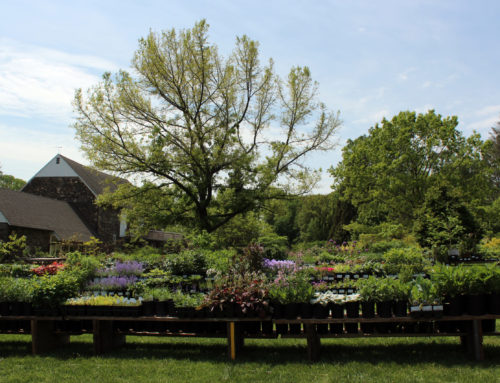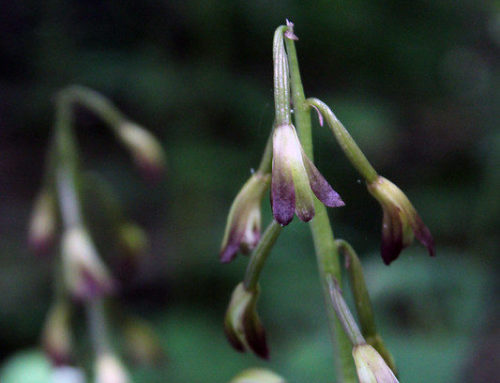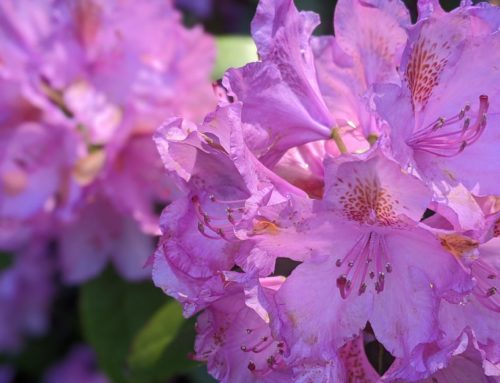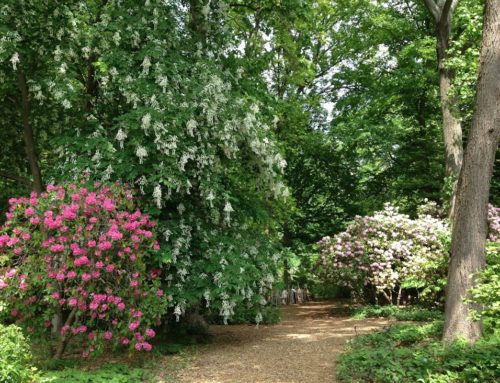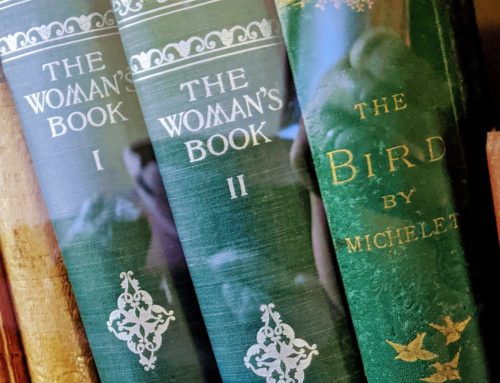One hundred and fifty years after Thomas and Margaret Minshall purchased the land that would become Tyler Arboretum, their sixth generation descendants, Jacob and Minshall Painter, began to plant trees. The land thus far had been farmed, used to grow crops and keep dairy cows. But Jacob and Minshall, who we call the Painter Brothers, were true citizen scientists in their day. Their fascination with the natural sciences led them to acquire a plant collection that numbered more than 1,100 individual plant specimens, which they planted in tidy rows that radiated out from their farmhouse like the spokes of a wagon wheel. Of these plants, planted between the 1840s and 1860s, 21 still grow at Tyler today.
That’s an impressive number when you consider that these trees and shrubs were planted somewhere between 180 and 160 years ago. I like to imagine all the history they’ve seen. When they were saplings, people travelled by horse and buggy on dirt roads through what was then still countryside. Now cars whiz past them on Painter Road in a highly urbanized county outside of the major city of Philadelphia. They withstood the Civil War, and the First and Second World Wars. They are now witnessing their second pandemic. They are truly sentinels, bearing witness to the passage of time. When I visit them, I like to think the scale of human concerns must seem very small. After all, in nearly 200 years they’ve seen almost everything.
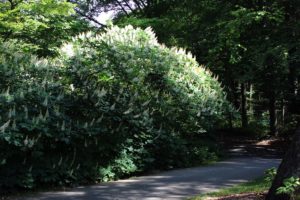
Aesculus parviflora, bottlebrush buckeye
These plants are the legacy left to us by the Painter Brothers, Jacob and Minshall. In many ways they are the legacy of the land itself, almost two centuries of growth recorded layer upon layer in their wood. But let’s get a little more specific and explore individual trees and shrubs that survive today. Nineteen species are represented in the 21 surviving plants. Eight are what would have been considered “exotic” in their day. Four are native to North America, but not trees you would naturally find in the local forest. Seven others are indigenous to this general area.
Three of the exotics are native to China: the Ginkgo, Mahonia and Yulan Magnolia. The Sawara False Cypress is from Japan. The 1800s were a time of great plant exploration in Asia. First in England and Europe and then in America, the craze for these exotic specimens exploded. Major city parks, private estates and public gardens of the day were acquiring them for their unique appeal to visitors.
It must have been quite the thing in their day for the brothers to plant the ginkgo that grows behind Lachford, a representative of this ancient species, found surviving the last ice age in Chinese monasteries. Likewise, the Mahonia and the Yulan Magnolia, are from China. This Asian magnolia was very different from its native North American cousins. It bloomed early in the spring on leafless branches, white stars against the bright blue sky. The native Cucumber and Frasier magnolias in their collection bloom late in spring and summer after the leaves have fully developed. The Yulan was destined to be the parent plant of many saucer and cup flowered hybrids we see in parks and suburban lawns today.
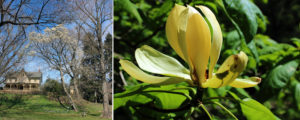
Magnolia denudata, yulan magnolia and Magnolia fraseri, frasier magnolia
The Painters’ Cedar of Lebanon was another exotic sight, as it acquired its distinctive silhouette against the rolling landscape. Sadly, our Painter specimen is in decline.
While the common pear has its origins in Europe and is therefore “exotic”, it was certainly ubiquitous by the time the Painters added it to the collection. Many fruit trees were represented in their collection, but only this one survives.
Some of the native trees in the collection also had an exotic quality given their rarity in the Northeast US. The giant sequoia groves were first noted by European explorer, J. K. Leonard in the western Sierras in 1833, and the first seeds were shipped east for propagation just six years before the Painter sequoia was planted. We know the tree was purchased from West Chester’s Hoopes Nursery, and perhaps their stock originated from these first seeds that came East. That would make our sequoia, which grows overlooking Painter Road, quite the pioneer.
Some of the other native plants traveled north to Pennsylvania from the American Southeast, like the bald cypress and bottle-brush buckeye. The Osage orange tree was first reported by European travelers in the Mississippi Valley. It was already well known to the native Americans who traded and used the wood for bows. Early settlers took advantage of its natural rot resistance for fence posts. Our sole tree was blown over in Hurricane Hazel in 1954, more than 60 years ago,, but the trunk remains amazingly intact proving the fact. Its thorny habit also made living fences for animal pens and field borders, as seen today when the large yellow-green fruit litter the local country roads in fall.
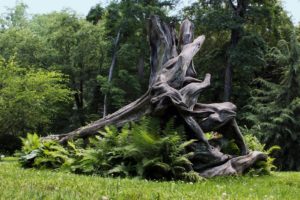
Maclura pomifera, osage orange
It is curious that the Painter brothers also planted indigenous trees in their collection. Perhaps they were interested in the ornamental possibilities of trees, like our surviving yellow buckeye and the Frasier magnolia. Maybe commercial uses of the gum from the American Sweetgum tree were something they wanted to explore, while the Switchcane bamboo might just have been a useful garden fence material or a wetland companion to the bald cypress trees.
We may only be able to make educated guesses about why they chose the trees they did. But if you consider the story of a tree’s life, that part is only the prologue. Some of it can be filled in from our records of where the seeds or saplings came from, and why they were being planted at the time. Still, the bulk of a tree’s story is what happens next — the early years when they are most vulnerable to deer browse and buck rub; its middle age when it puts on wood and its canopy is lush and full; and its venerable years, when its height and spread is a marvel to see. Its story can be found in the years of carbon stored in the rings of wood, by the birds, squirrels, chipmunks, deer and insects it has fed with its leaves, flowers, fruits and nuts.
At Tyler, we do our best to support this living legacy. We’ve fenced in the specimen trees so that no foot traffic compacts the soil which contains precious roots. Our Horticulture team mulches around them so that they do not mow around their trunks or near surface roots. Lightning systems were installed on the ginkgo and sequoia so that they would be protected from summer storms. The sequoia is treated yearly for the fungal diseases that plague these trees, grown so far from their native range. They are monitored to see if they need fertilizing or watering if the summer is hot and dry.
Otherwise they are left to grow; to live their lives as trees. Stop by and visit them next time you are at Tyler. You’ll know them by their blue tags, which tell you that they are one of these legacy plants. Consider for a moment all that they have seen, and all that they might still witness.
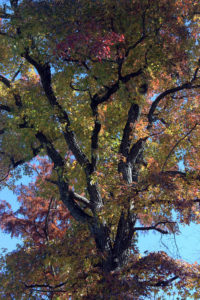
Liquidambar styraciflua, sweetgum
| American Linden (Tilia americana) | Origin |
| Bald-cypress (Taxodium distichum) 2 Specimens | Native |
| Bottlebrush Buckeye (Aesculus parviflora) | Native |
| Cedar of Lebanon (Cedrus libani) | Exotic – Mediterranean |
| Common Pear (Pyrus communis) | Exotic – Europe |
| Corsican Pine (Pinus nigra spp. laricio) | Exotic – Mediterranean |
| Cucumbertree Magnolia (Magnolia acuminata) | Native |
| Fraser Magnolia (Magnolia fraseri) | Native |
| Giant Sequoia (Sequoiadendron giganteum) | Native |
| Ginkgo (Ginkgo biloba) | Exotic – China |
| Leatherleaf Mahonia (Mahonia bealei) | Exotic – China |
| Oriental Spruce (Picea orientalis) | Exotic – Caucus, Turkey |
| Osage-orange (Maclura pomifera) | Native |
| River Birch (Betula nigra) | Native |
| Sawara False Cypress (Chamaecyparis pisifera) | Exotic – Japan |
| Sweetgum (Liquidambar styraciflua) 2 specimens | Native |
| Switchcane Bamboo (Arundinaria gigantea ssp. tecta) | Native |
| Yellow Buckeye (Aesculus flava) | Native |
| Yulan Magnolia (Magnolia denudata) | Exotic – China |


